Click image for BBB rating
See our Privacy Policy
cool="cool" width="784" height="7583" border="0" cellpadding="0" cellspacing="0" gridx="16" showgridx="showgridx" usegridx="usegridx" gridy="16" showgridy="showgridy" usegridy="usegridy" bgcolor="#99ccff">
|
 |
|
|
|
|
|
|
Welcome to Spaightwood Galleries, Inc.
120 Main Street, Upton MA 01568-6193
You can follow us on Facebook and Twitter!
We blog regularly on Facebook and announce special events and special sales on both sites.
|
|
|
|
For Catholics during the middle ages and the Renaissance, the Crucifixion was an ever-recurring event: with each newly-committed human sin, Jesus suffered and died yet again (for an early twentieth-century version of this belief, click here to see Georges Rouault's Miserere 35, "Jésus sera en agonie jusqu'a la fin du monde" / "Jesus will be in agony, even to the end of the world"; the title, significantly, comes from the 17th-century French philosopher Blaise Pascals' Pensées). The image of Christ on the cross is everywhere in Medieval and Renaissance art, yet the use of those images could be suspect. If it was intended merely to raise pathos, the images should be rebuked (as Michelangelo, who himself made some ravishing drawings of the Crucifixion, rebuked the all-too-realstic depictions of the Crucifixion in 15th- and early 16th-century Netherlandish art) and as Protestant iconoclasts in those parts of Germany where Lutheranism triumphed, in the Netherlands, and in England, demonstrated when they attempted to purge their churches of these relics of superstitious adoration. Yet at the same time these lovers of St. Paul's Epistles were also fixated on what was for them the meaning of the Crucifixion and for what we need to learn about ourselves from contemplating it: As St. Paul wrote in his first epistle to the Corinthians, "the message about the cross is foolishness to those who are perishing, but to us who are being saved it is the power of God. For it is written, 'I will destroy the wisdom of the wise, and the discernment of the discerning I will thwart.' Where is the one who is wise? Where is the scribe? Where is the debater of this age? Has not God made foolish the wisdom of the world? For since, in the wisdom of God, the world did not know God through wisdom, God decided, through the foolishness of our proclamation, to save those who believe. For Jews demand signs and Greeks desire wisdom, but we proclaim Christ crucified, a stumbling block to Jews and foolishness to Gentiles, but to those who are the called, both Jews and Greeks, Christ the power of God and the wisdom of God. For God’s foolishness is wiser than human wisdom, and God’s weakness is stronger than human strength. Consider your own call, brothers and sisters: not many of you were wise by human standards, not many were powerful, not many were of noble birth. But God chose what is foolish in the world to shame the wise; God chose what is weak in the world to shame the strong; God chose what is low and despised in the world, things that are not, to reduce to nothing things that are, so that no one might boast in the presence of God. He is the source of your life in Christ Jesus, who became for us wisdom from God, and righteousness and sanctification and redemption, in order that, as it is written, 'Let the one who boasts, boast in the Lord.' (I Corinthians 1: 18-31). In the "fact" of the Crucifixion–for Protestants an act in historical time that happened for a purpose and has fulfilled its purpose–to repair the rent in humanity's relationship with God and thus to accomplish the salvation of those who are called to believe. God, to reconcile man to God, died the death promised in Genesis to those who disobeyed God's command not to eat from the Tree of the Knowledge of Good and Evil and thus enabled eternal life to be restored to those chosen by God. The use of the Cross, for Erasmus, especially in his most popular work, the Encomium Moriae or The Praise of Folly was to force readers to set aside reason and turn to God through faith, something that explains its great popularity in Protestant countries (John Milton in a letter from college to his father tells him that everyone at Cambridge written in the early 1620s is reading the work) contrasts with its presence, post Council of Trent, on the Catholic Index of Forbidden Books.
|
|
|
|
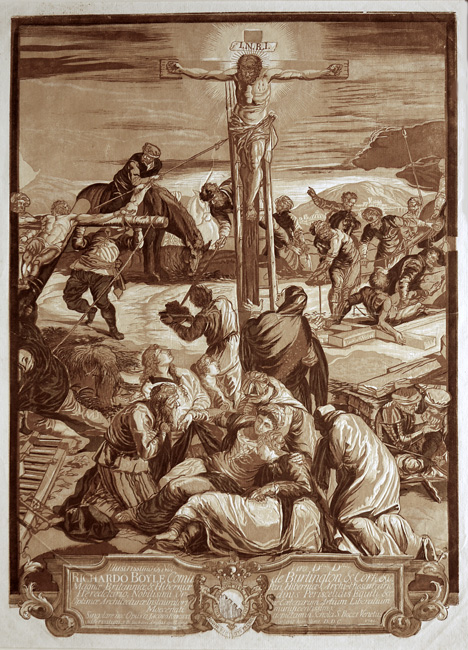 |
|
|
|
John Baptist Jackson (English, c. 1700-c. 1777) The Crucifixion (Kainen 22). Chiaroscuro woodcut after Tintoretto, 1741. Edition unknown. This is the central panel in a tryptic based upon Jacopo Tintoretto's Crucifixion in the Scuola di San Rocco. Jackson was the last of the great chiaroscuro woodcut masters. His works have been studied in a monograph published by the Smithsonian Institution. There is a horizontal fold half-way down the woodcut ad a diagonal crease going through the bottom left side of the cartouche. A large work! Image size: 571x410mm. Price: Please call or email for current pricing information.
|
|
|
|
|
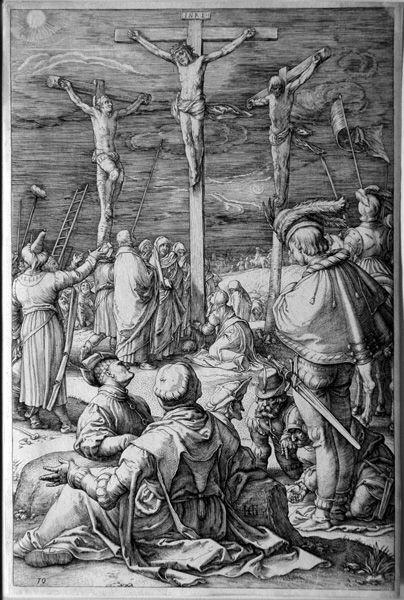 |
|
|
|
Hendrik Goltzius (Dutch, 1558-1617), Calvary (Bartsch 36, Hirschmann 30, Strauss 354 i/ii). Original engraving, 1598. A beautiful impression on laid paper of the first state of two. Signed, dated, and numbered 10 in the plate. Watermark: Coat of Arms with a Tower (Briquet 2291, 1592-96). Thread margins on all sides. Strauss notes that the Calvary scene does not exist in either of Dürer's Passion cycles or that of Lucas van Leyden (who did, of course treat the subject separately in the large composition shown above), though there is a single Durer woodcut that might have influenced Goltzius. Image size: 196x130mm. Price: Please call or email for current pricing information.
|
|
|
|
|
|
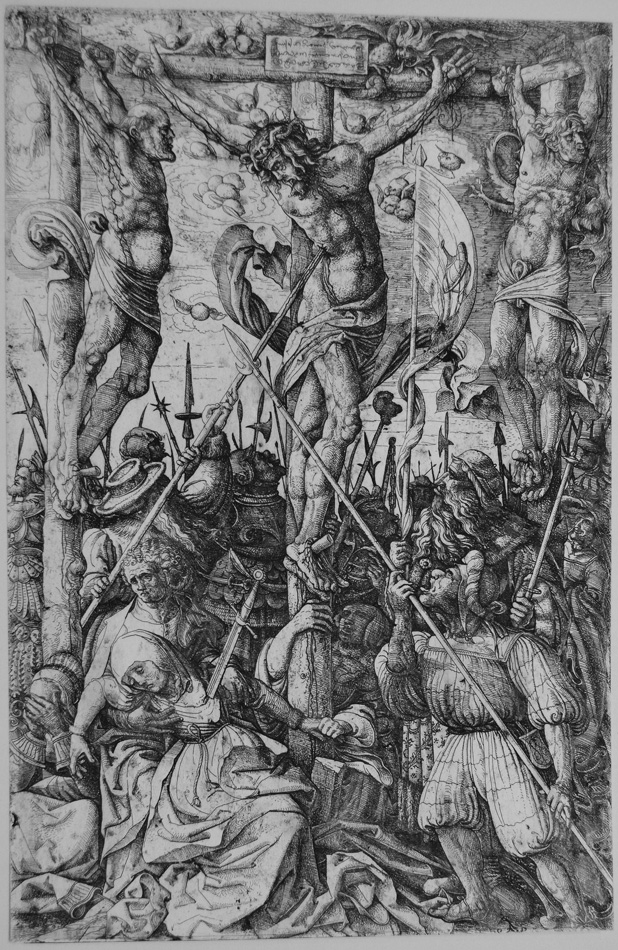 |
|
|
|
Daniel Hopfer (b. Kauffbeuren c. 1470-1536 Augsburg). Hopfer's became a citizen of Augsburg in 1493 and was added to the roster of painters; he married in 1497 and had two sons, Hieronymous (Jerome) and Lambert, both of whom also became artists. Daniel began as an etcher of armor and was one of the first (if not the first) to make etchings on paper using thin sheets of iron alloy that did not rust so much as the iron Dürer would later use.
The Crucifixion (B. 14 ii/ii). Original etching. Ours is a beautiful impression of the second state printed on wove paper with the Funck number trimmed away. Lifetime impressions tend to be less contrasty; this late impression is quite strong. The border line above the added text is just barely visible at bottom. Hopfer and his sons claimed to be the first to make etchings and taught Dürer how to make etchings. Image size: 328x216mm. Price: Please call or email for current pricing information.
Appearances to the contrary, the print is rectangular.
|
|
|
|
|
|
|
|
|
|
 |
|
|
|
Lucas van Leyden (Dutch, 1494-1533), Golgotha (B. 74, L. 99, New Holl. 74ii/vi), Original etching with later hand coloring, 1517. One of Lucas' largest prints, here in a very rare and beautiful exemplar. The reversed date of the first state (lower right) has been corrected (second state), but none of the signs of the third to sixth states appear to be present, although the hand-coloring makes it difficult to be certain: the shadows on the shoulder of the cripple do not appear to have been reemphasized and there is no visible cross hatching on the shoulder (added in the third state); the clouds top right appear to be all present, though partially obscured by the hand-coloring. Printed on laid paper with chain marks every 1-1/8 inches with no visible watermark. Lucas is considered the finest Netherlandish printmaker of the first half of the 16th century both by his contemporaries and by modern art historians. It is possible that many prints were sold and then hand-colored by local artists for people who could not afford a painting. As in W. H. Auden's poem, "Musée de Beaux Arts," Lucas van Leyden, like Pieter Bruegel after him, understood "That even the dreadful martyrdom must run its course / Anyhow in a corner, some untidy spot / Where the dogs go on with their doggy life and the torturer's horse / Scratches its innocent behind on a tree." So in this masterpiece, the Crucifixion takes place in the upper left, while in the lower left, two people are fighting and one is about to stab another over a piece of cloth (probably an allusion to the soldier's gambling over Jesus' clothing, but here vulgarized. Above them, two people, ignoring the Crucifixion, are chatting as they walk. Bottom center, a boy plays with his dog, above them four well-dressed men are chatting, and although one is pointing in the direction of the crosses, seen more carefully, he is pointing at the two people walking away from the Crucifixion and in their general direction. Further right, a mother holds her baby, apparently oblivious to the action going on top left like the two men racing their horses top right and the group of travellers, behind and below the hill of Golgotha are passing through the scene to go about their business elsewhere. Image size: 276x403mm. Price: Please call or email for current pricing information.
|
|
|
|
|
|
 |
|
|
|
Adrien Collaert (Antwerp, c. 1560-1618), Christ nailed to the Cross (New Hollstein 220iv/iv), Engraving after Maarten de Vos, 1598. Number 47 of a series of 51 engravings on The Life, Passion and Resurrection of Christ. Our impression is from the 4th state published by Joan Galle in 1638. The series was very popular and printed several times by itself and used as well in other series, including the Theatricum Biblicum (1643). Ours is a very good impression with wide margins in very fresh condition. Image size: 185x218mm. Price: Please call or email for current pricing information.
|
|
|
|
|
|
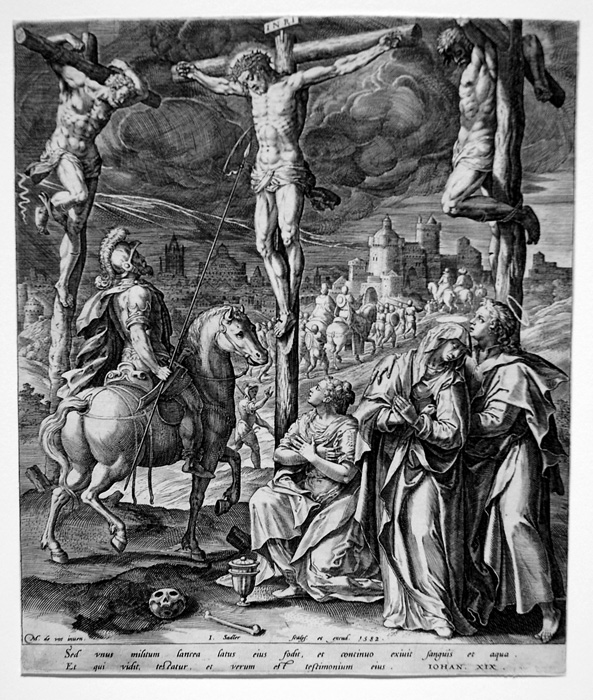 |
|
|
|
Jan Sadeler (Dutch, 1550-1600), Crucifixion with the two thieves (Hollstein 230, TIB 7001.192). Engraving after a lost drawing by Maarten de Vos, 1582. The Centurion has just stabbed Jesus with his spear, the three people who had been crucified are dead, the crowds have left, and only the Centurion, St. John, the Virgin Mother, and Mary Magdalen remain. This is one of 11 scenes from The Passion that Sadeler engraved after drawings by Maarten de Vos and published in 1582. A very good impression trimmed on or within the platemark. Image size: 238x202mm. Price: Please call or email for current pricing information.
|
|
|
|
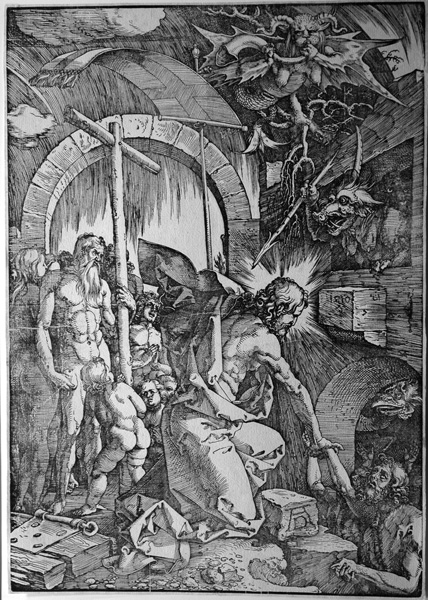 |
|
|
|
Albrecht Durer (Nuremburg, 1471-1528), The Harrowing of Hell (B. 14, S. 150, M., H. 121). Original woodcut, signed in the block and dated 1510 on the ledge to the right of Jesus' head as he reaches down to pull John the Baptist out of the dungeons of Hell. Behind and to the left of Jesus, a very brawny Adam holds the cross and Eve stands to the left of him. According to Meder, some proofs before the 1511 edition with Latin text verso and impressions from the 1511 edition have a small gap in the pole from which the banner of the resurrection flies; impressions after the 1511 edition show a 40mm (nearly two inch) gap. Since ours has a 2 mm gap and lacks the Latin text, it seems to be a proof before 1511: a very good dark impression with strong contrasts. There is a very elaborate watermark which I cannot identify. There is a horizontal fold visible from Eve's back on the left to Jesus' shoulder and another running from the ledge with the date. Image size: 395x279mm. Price: Please call or email for current pricing information.
|
|
|
|
|
|
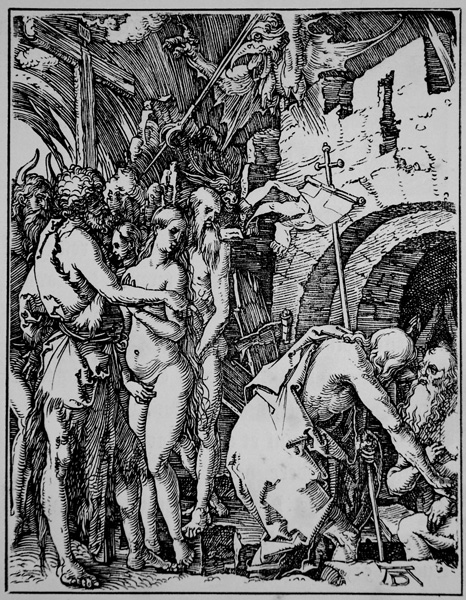 |
|
|
|
Albrecht Durer (Nuremburg, 1471-1528), Christ Harrowing Hell (B. 41, S. 125) Original woodcut, c. 1509 for the Small Passion. In 1844 plaster casts were made from Durer's original woodblocks for the Small Woodcut Passion, which had just been acquired by the British Museum. From these casts, metal plates were made and a small edition produced. Our impression is from this edition. St. John the Baptist, Adam, and Eve have already been pulled from the pit; Jesus is here rescuing one of the patriarchs. Image size: 127x97mm. Price: Please call or email for current pricing information.
|
|
|
|
|
|
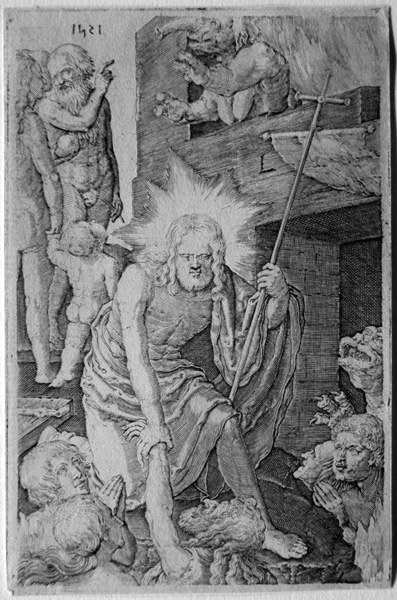 |
|
|
Lucas van Leyden (Dutch, 1494-1533), Christ in Limbo (Bartsch 55, New Hollstein 55). Ours is a copy by Jan Harmansz. Muller (Van Leyden, Bartsch 55 a; Muller, Bartsch 54). Muller (Amsterdam, 1571?-after 1625) worked in Goltzius' studio and engraved many of his designs, also participated in the Goltzius-led revival of Lucas van Leyden and made copies of the complete Lucas van Leyden Passion. Our impression is a good but light impression on laid paper trimmed on or inside the platemark. Image size: 116x76mm. Price: Please call or email for current pricing information.
|
|
|
|
|
|
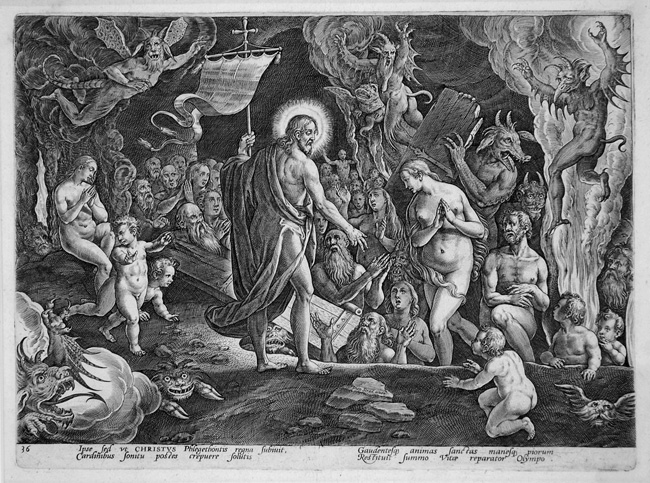 |
|
|
|
Jan Sadeler (Dutch, 1560-1600), Christ Harrowing Hell (Hollstein 230). Engraving after Stradanus, 1582. A very fine impression on laid paper. Much energy has gone into depicting the impotent rage of the devils as Christ breaks down the doors of Hell to rescue mankind, beginning with Eve. Large margins. Stradanus (Jan van der Straet [Bruges 1523-1604 Florence] was active in Vasari's circle. In between painting commissions, however, he provide many drawings to print publishers for engravings. Image size: 193x264mm. Price: Please call or email for current pricing information.
|
|
|
|
Spaightwood Galleries, Inc.
To purchase, call us at 1-800-809-3343 (1-508-529-2511 in Upton MA & vicinity) or send an email to spaightwood@gmail.com.
We accept AmericanExpress, DiscoverCard, MasterCard, and Visa.
We also accept wire transfers and paypal.
For directions and visiting information, please call. We are, of course, always available over the web and by telephone (see above for contact information). Click the following for links to past shows and artists. For a visual tour of the gallery, please click here. For information about Andy Weiner and Sonja Hansard-Weiner, please click here. For a list of special offers currently available, see Specials.
All works are sold with an unconditional guarantee of authenticity (as described in our website listing).
Copyright 2004-2017, Spaightwood Galleries, Inc.
Go back to the top of this page.
Visiting hours: Saturday 10:00 am to 5:00 pm and Sunday noon to 6:00 pm and other times by arrangement.
Please call to confirm your visit. Browsers and guests are welcome.
|
|
|
|
|
|
|
|
|
|
|
|
|
|
|
|
|
|
|
|
|
|
|
|
|
|
|
|
|
|
|
|
|
|
|
|
|
|
|
|
|
|
|
|
|
|
|
|
|









